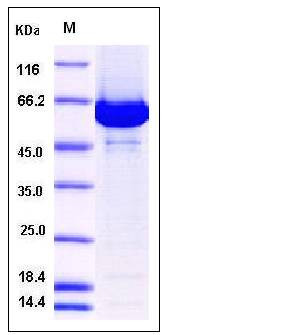Human ACOX1 / aox Protein (His Tag)
ACOX,PALMCOX,SCOX
- 100ug (NPP1863) Please inquiry
| Catalog Number | P11266-H07B |
|---|---|
| Organism Species | Human |
| Host | Baculovirus-Insect Cells |
| Synonyms | ACOX,PALMCOX,SCOX |
| Molecular Weight | The recombinant human ACOX1consists of 679 amino acids and has a calculated molecular mass of 76.7 kDa. It migrates as an approximately 60 kDa band in SDS-PAGE under reducing conditions. |
| predicted N | Met |
| SDS-PAGE |  |
| Purity | > 92 % as determined by SDS-PAGE |
| Protein Construction | A DNA sequence encoding the human ACOX1 (AAH08767.1) (Met 1-Leu 660) was expressed, with a polyhistidine tag at the N-terminus. |
| Bio-activity | |
| Research Area | Cancer |Cancer Metabolism |Metabolic signaling |Metabolism of lipids and lipoprotein |
| Formulation | Lyophilized from sterile 20mM Tris, 500mM NaCl, pH 7.0, 20% gly, 3mM DTT 1. Normally 5 % - 8 % trehalose, mannitol and 0.01% Tween80 are added as protectants before lyophilization. Specific concentrations are included in the hardcopy of COA. |
| Background | Peroxisomal acyl-coenzyme A oxidase 1(ACOX1 or AOX) is the first enzyme of the fatty acid beta-oxidation pathway and belongs to the Acyl-CoA oxidase family. Human liver peroxisomes contain two acyl-CoA oxidases, namely, palmitoyl-CoA oxidase (ACOX1/AOX) and a branched chain acyl-CoA oxidase. The palmitoyl-CoA oxidase (ACOX1/AOX) oxidizes the CoA esters of straight chain fatty acids and prostaglandins and donates electrons directly to molecular oxygen, thereby producing H2O2. Human ACOX1/AOX is a protein of 661-amino acids, including the carboxyl-terminal sequence(Ser-Lys-Leu) known as a minimal peroxisome-targeting signal. Human ACOX1/AOX, the first and rate-limiting enzyme of the peroxisomal β-oxidation pathway, has two isoforms including ACOX1a and ACOX1b, transcribed from a single gene. The human ACOX1b isoform is more effective than the ACOX1a isoform in reversing the Acox1 null phenotype in the mouse partly because of the Substrate utilization differences. |
| Reference |
